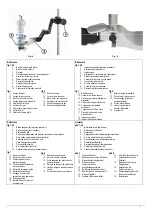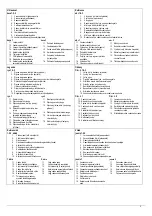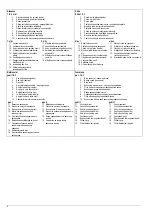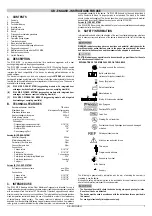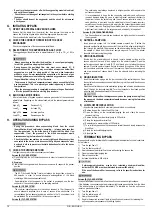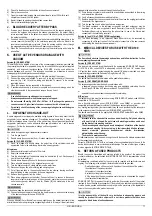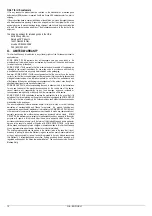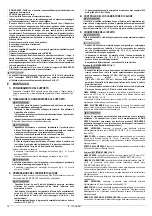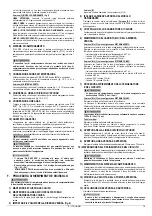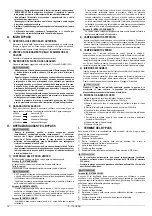
10
GB - ENGLISH
- Do not turn the heater-cooler off with the oxygenating module blood inlet
and outlet lines clamped.
- Check the correct dosage of anticoagulant in the system before starting
the bypass.
- The user should inspect the oxygenator and the circuit for air removal
prior bypass.
G. INITIATING
BYPASS
1) OPEN THE ARTERIAL AND VENOUS LINES
Remove first the clamp from the arterial line, then remove the clamp on the
venous line. Start the bypass with a
blood flow appropriate to patient size.
Check constantly the blood level in the Venous Reservoir.
2) CHECK THE CORRECT OPERATION OF THE HEAT
EXCHANGER
Check the temperature of the venous and arterial blood.
3) SELECTION OF THE APPROPRIATE GAS FLOW
The suggested gas/blood flow ratio in normothermia is 1:1 with a
FiO
2
of 80 to
100%.
- Always open the gas flow after the blood flow. In case of pump stopping,
turn off the gas before stopping the blood flow.
- During bypass, the gas/blood flow ratio must never exceed 2:1. A
phenomenon called “wet lung” may occur when microporous hollow fiber
oxygenators are used for a
long period of time and when temperature
gradients occur. If water condensation associated with decrease of gas
exchange performance is noted during extended oxygenator use, increase
the gas/blood flow ratio up to 4:1 for 10 minutes.
- The pressure in the blood compartment must always exceed that of the
gas compartment. This is to prevent gas emboli appearing in the blood
compartment.
- When the priming procedure is completed, make sure the gas flow is kept
off for the period of time before starting the procedure.
4) BLOOD GAS MONITORING
After a
few minutes of bypass operation, measure gas content of the venous and
arterial blood. Depending on the values found, adjust the relevant parameters as
follows:
High pO
2
Decrease FiO
2
Low pO
2
Increase
FiO
2
High pCO
2
Increase gas flow
Low pCO
2
Decrease gas flow
H. OPERATION DURING BYPASS
- During the procedure, when sequestering blood from the circuit
(hemofiltration, blood cardioplegia, sampling, …) always make sure that
the flow generated by the main pump is higher that the blood flow
sequestered. If not, the pressure in the blood compartment would
decrease causing the formation of air bubbles.
-
Check that all luer connections are securely tightened. All accessory lines
connected to the device must be connected tightly and stopcocks must
be closed in order to prevent accidental introduction of air into the device
or blood loss.
1) CHECK THE VENOUS RETURN
If a
higher venous return flow is necessary act as follows:
Version [B], CLOSED SYSTEM
a) Open completely the soft reservoir squeezer in order to increase the reservoir
volume.
All versions
b) Lower both the oxygenator and the venous reservoir with respect to the patient
position.
- The ACT (Activated Clotting Time) must always be longer than or equal to
480
seconds in order to ensure adequate anticoagulation of the blood
circulating within the extracorporeal circuit.
- If administration of anticoagulant to the patient is envisaged, use the luer
connector of the central stopcock on the sampling manifold.
Version [A], OPEN SYSTEM
- The minimum operating volume in the venous reservoir is 10 ml. However to
ensure adequate response time in case of venous inflow obstruction, it is
recommended that an adequate volume in addition to the 10 ml minimum level
be maintained. Do not exceed 500 ml in the venous reservoir.
Version [B], CLOSED SYSTEM
- The cardiotomy must always be placed in a
higher position with respect to the
soft venous reservoir.
- It is recommended to keep the line connecting cardiotomy and soft venous
reservoir clamped during the case, in order to prevent massive air delivery to
the patient in case the cardiotomy and the soft venous reservoirs empty. In
case blood has to be moved from the cardiotomy to the soft venous reservoir,
carefully open the clamp and avoid to empty the line connecting cardiotomy and
soft venous reservoir. Emptying the cardiotomy and the soft venous reservoir
might result in air delivery to the oxygenator and, eventually, to the patient.
Version [C], OXYGENATING MODULE
- The Venous Reservoir must always be placed in a
higher position in respect to
the oxygenator.
2) ARTERIAL SAMPLING
Insert a
sample syringe into the arterial sample stopcock luer. Position the
stopcock handles toward the access ports of the manifold to allow arterial blood to
flow through the manifold. The pressure on the arterial side will allow flow. Draw
the sample of blood from the arterial sample stopcock. Turn off the arterial
stopcock before removing the syringe.
3) VENOUS SAMPLING
Ensure that the arterial stopcock is closed. Insert a
sample syringe into the
venous stopcock luer and a
flush syringe into the center stopcock. Open the
center stopcock and draw at least 10-15 ml of blood prior to taking the venous
sample. Close the center stopcock. Return this blood through one of the filtered
luer connectors positioned on the top of the reservoir. Open the venous stopcock
and draw a
sample of venous blood. Close the stopcock before removing the
syringe.
4) DRUGS INJECTION
Insert the medication syringe into the luer connector of the central stopcock. Open
the central and venous stopcocks and inject the drug into the manifold and venous
sample line.
Close the central stopcock to the medication syringe and allow an arterial-venous
“wash” through the stopcock manifold. Turn the stopcocks to the closed position
when the drug has been delivered to the venous line.
Draw blood samples from the stopcocks only when the pump is running. If not,
the pressure in the blood compartment would decrease causing the formation
of air bubbles.
5) LOW FLOW RECIRCULATION
(Hypothermia associated with circulatory arrestor stand-by conditions).
a) Reduce the gas flow to less than 200 ml/min.
b) Open the clamp on the recirculation/purging line and clamp the venous
reservoir inlet line.
c) Reduce the flow from the arterial pump to 200 ml/min.
d) Clamp the oxygenator arterial line.
e) Recirculate at a
maximum flow of 200 ml/min.
f) To re-initiate bypass open the venous and arterial lines and slowly increase the
blood flow.
g) Clamp the recirculation/purging line.
h) Adjust gas flow.
I. TERMINATING
BYPASS
Bypass should only be terminated after considering individual patient’s clinical conditions.
Act as follows:
1)
Turn the gas flow off.
2)
Turn the heater-cooler off.
3)
Slowly decrease the arterial flow to zero while closing the venous line.
4)
Open the recirculation/purging line.
5)
Clamp the arterial line.
6)
Increase arterial flow to 200 ml/min.
- If extracorporeal circulation may be later restarted, a
minimum blood flow
inside the D100 KIDS must be maintained (maximum 200 ml/min).
-
If the use of the haemofilter is necessary, refer to its specific instructions for
use.
Version [B], CLOSED SYSTEM
In case of insufficient venous return flow the soft venous reservoir might collapse.
If this happens, consequent negative pressure might cause gas extraction from the blood
if the arterial pump is not stopped immediately. To eliminate air from the soft venous
reservoir, proceed as follows:
1)
Turn the gas flow off.
2)
Turn the arterial pump off.
3)
Clamp the arterial line.
4)
Restore the required volume of liquid in the soft venous reservoir (by releasing the
soft venous reservoir squeezer or by adding liquids).
Содержание KIDS D100
Страница 2: ...2 Fig 1 Fig 3 Fig 2 ...



